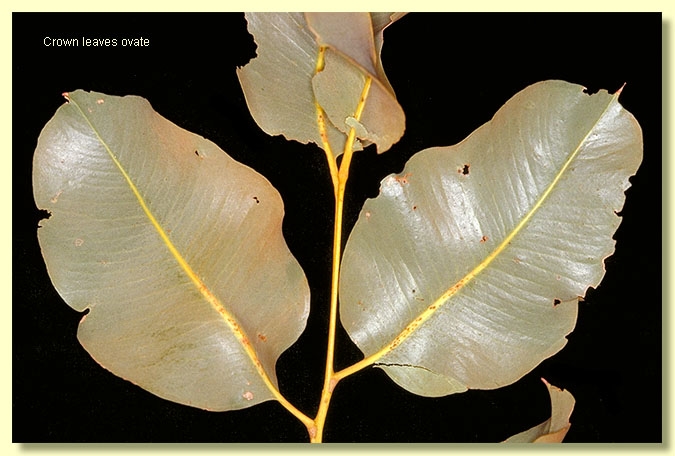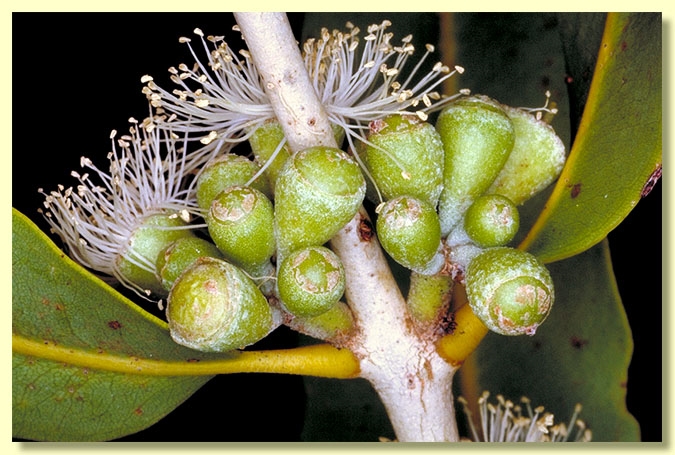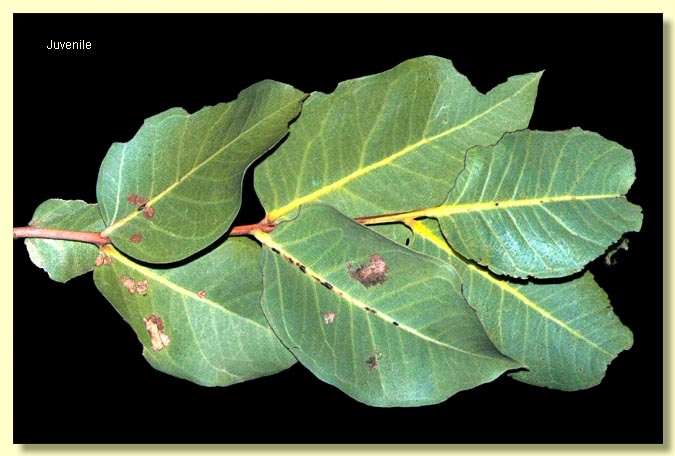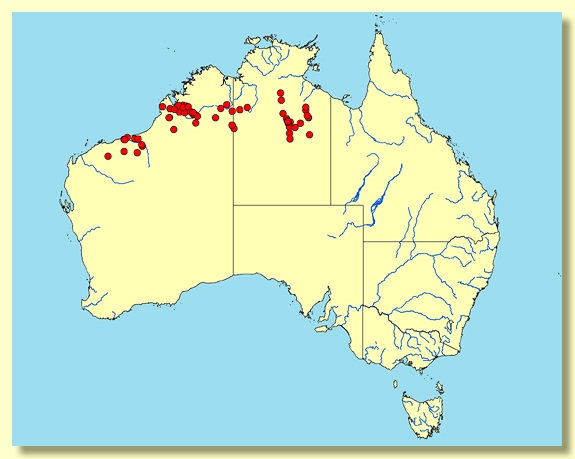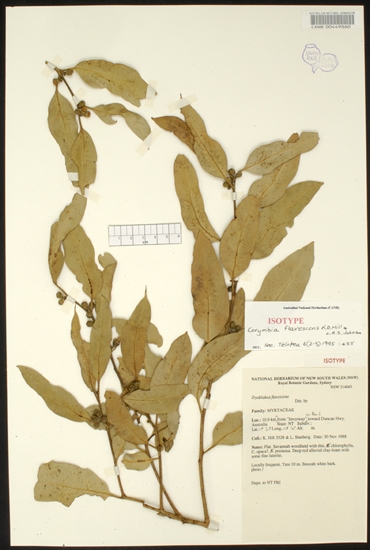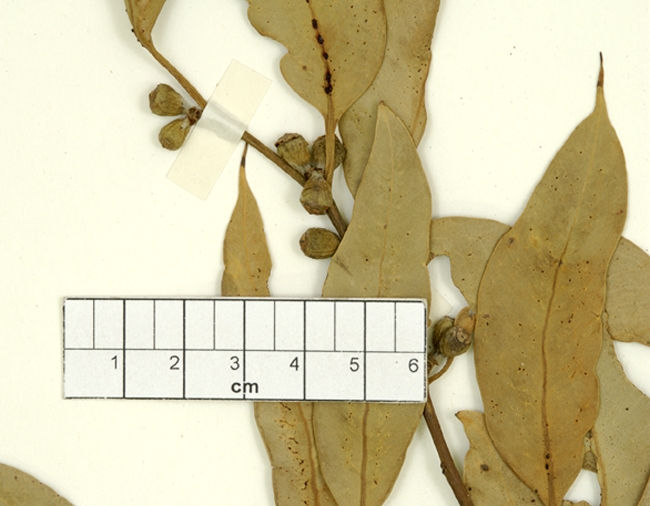Euclid - Online edition
Corymbia flavescens
Corymbia | Blakearia
Corymbia flavescens K.D.Hill & L.A.S.Johnson, Telopea 6: 455 (1995).
Tree to 15 m tall. Forming a lignotuber.
Bark smooth throughout, powdery, shedding in thin greyish yellow scales to reveal vivid white.
Branchlets lack oil glands in the pith; non-glaucous, smooth, yellowish.
Juvenile growth (coppice or field seedlings to 50 cm): stems rounded in cross-section, scabrid with the remains of bristle-glands or smooth; juvenile leaves shortly petiolate, opposite, oblong to cordate to ovate or becoming elliptical, 7–15.5 cm long, 4.5–11 cm wide, base lobed or truncate to rounded, yellowish green, slightly scabrid or smooth.
Crown predominantly of adult leaves, however, opposite to sub-opposite, undulate, broader intermediate-type leaves are sometimes also present and may subtend inflorescences. New growth often silvery (but not waxy).
Crown leaves mostly alternate, petioles (0.4)0.8–2 cm long; blade ovate to lanceolate, (6)7–23.5 cm long, 1.3–6(7) cm wide, base tapering to petiole or rarely rounded, margin entire, apex pointed, concolorous or slightly discolorous, stiff, undulate, glossy or only slightly so, yellow-green, side-veins at greater than 45° to midrib, reticulation very dense, intramarginal vein present, oil glands apparently absent.
Inflorescence axillary compound, with rhachis internodes very shortened (condensed) often with only the basal internode obvious and usually < 0.4 cm long, the whole structure may be easily misinterpreted as a single axillary umbel; peduncles rounded, 0–0.5 cm long; buds usually 3 per umbel, sometimes single, the actual number difficult to discern, pedicellate (pedicels 0.2–0.6 cm long). Mature buds obovoid to pyriform, 0.6–0.9 cm long, 0.5–0.8 cm wide, smooth or rarely slightly scurfy, scar present (outer operculum shed early, whole or in scaly fragments), operculum shallowly rounded, stamens inflexed, all fertile, anthers oblong, dorsifixed, versatile, dehiscing by longitudinal slits, style long and straight, stigma blunt, locules 3, the placentae each with ca 5 or 7 vertical ovule rows, but the rows ± indistinct. Flowers white, perfumed.
Fruit pedicellate (pedicels 0.2–0.7 cm long), cupular to cylindrical to barrel-shaped or almost obconical, 0.8–1.2 cm long, 0.8–1.1 cm wide, thin-walled, disc descending vertically, valves 3, enclosed.
Seeds not seen (other ghost gum species have brown, saucer-shaped seed, smooth on both sides with hilum ventral).
Cultivated seedlings (measured at ca node 10): not grown.
Flowering has been recorded in November and December.
A ghost gum distributed from near Port Hedland, Broome and Derby in Western Australia east through the southern fringe of the Kimberley region as far north as Mount Elizabeth station, but absent from the Great Sandy Desert. Extending east into the Northern Territory south from about Larrimah to Tennant Creek, extending to the Barkly Tableland. It has also been recorded for Queensland in the area north of Mount Isa where collections have been made from Adel's Grove and Dugald River (fide Hill & Johnson, 1995, p. 456). Corymbia flavescens is distinguished from other ghost gum species in this area by its completely smooth bark, crown of predominantly adult, yellow-green, glabrous leaves, and buds and fruit on short pedicels (<0.6 cm) arranged in a condensed axillary inflorescence.
In the west of its range C. flavescens may be confused with C. paractia, a tumble-down ghost gum restricted to the Broome area north towards Cape Bertholet on subcoastal dunes. C. paractia has shorter leaves that are not so yellow-green and longer pedicels (0.5–1.2 cm) on the buds compared with C. flavescens. Further east, two other smooth-barked ghost gums occur that might be confused with C. flavescens, viz. C. bella, which has a finer greener crown of narrow leaves and an expanded axillary inflorescence with several internodes obvious; and C. grandifolia subsp. grandifolia, which has very glossy adult leaves in the crown and larger buds on much longer pedicels (0.8–2.3 cm long) compared with C. flavescens.
On the southern fringe of the range of C. flavescens, the only species likely to be confused is C. aparrerinja from desert areas of central Australia. The ranges of the two species overlap near Tennant Creek and they may be distinguished by the coarser, yellow-green crown leaves in C. flavescens, and greener and narrower crown leaves in C. aparrerinja. Plants of intermediate form between these two species may be found on the Barkly Tableland. East of Mount Isa and south and south-east of Normanton coarse-leaved smooth-barked ghost-gums have been mis-identified as C. flavescens, but the highly glossy crown leaves, long pedicels and large fruit readily identify them as C. grandifolia subsp. grandifolia. Further east from this area the common smooth-barked ghost gum is C. dallachiana which has much narrower crown leaves with longer petioles than C. flavescens but with similar short pedicels and fruit size. Plants intermediate in character may also occur in this area.
In Western Australia to the south of Port Hedland several groves of ghost gum trees of probable hybrid origin, involving C. flavescens and C. candida, occur on flat areas of clayey soil. These trees were described as C. candida subsp. lautifolia by Hill & Johnson (1995). The populations show wide variation in foliage characters especially, and this subspecies is not included in EUCLID.
MORE ABOUT CORYMBIA
MORE ABOUT GHOST GUMS
Corymbia flavescens: Latin flavescens, becoming yellow, referring to the foliage and branchlets which are yellow-green.




